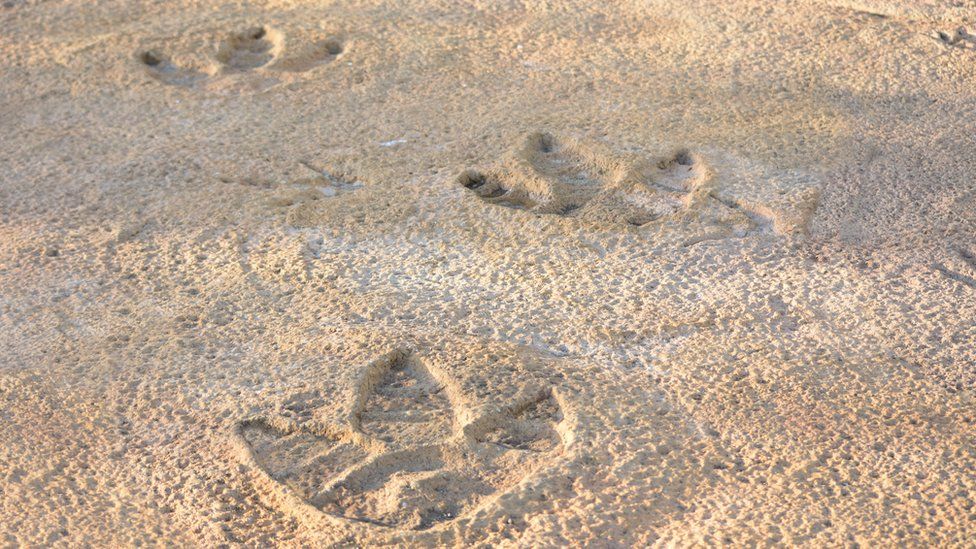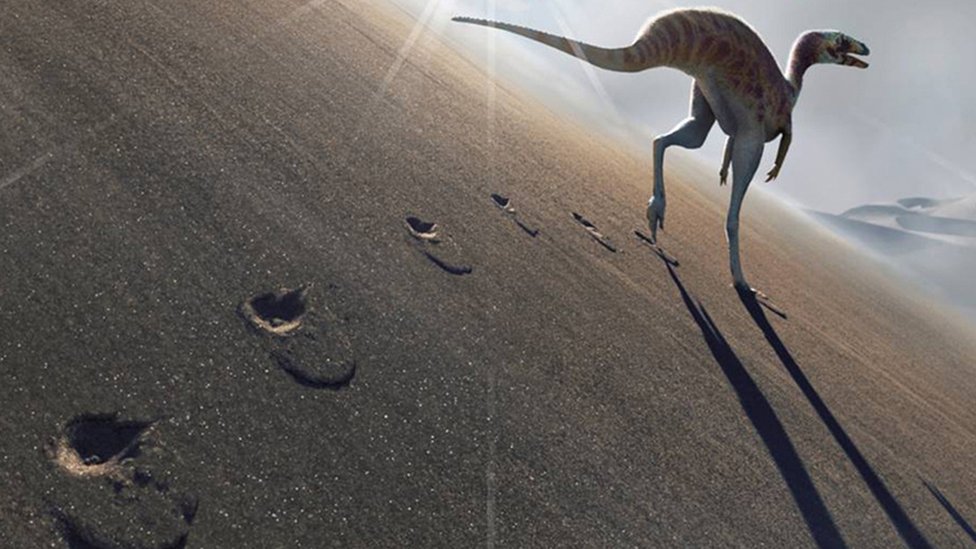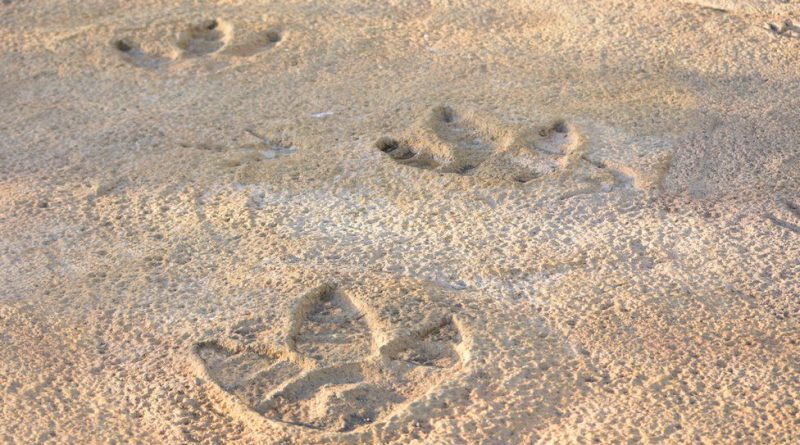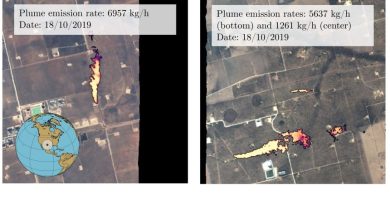Scientists Discover A New Dinosaur Species From Footprints In Brazil
In the vast expanses of Brazil’s Botucatu Formation, where time has preserved the echoes of Earth’s ancient past, scientists have unearthed a remarkable discovery – the footprints of a previously unknown dinosaur species. This revelation, named Farlowichnus rapidus, is reshaping our understanding of the diverse prehistoric ecosystems that once thrived in the region. In the 1980s, an Italian priest and palaeontologist named Giuseppe Leonardi stumbled upon these fossilized footprints, setting in motion a journey of meticulous study and scientific revelation.

The Origins of Farlowichnus rapidus: A Palaeontological Odyssey
In the 1980s, amid the rugged beauty of Brazil’s Botucatu Formation, Giuseppe Leonardi uncovered a series of dinosaur footprints that would captivate the imaginations of scientists for decades to come. These fossilized imprints, later termed “trackways,” became the focal point of Leonardi’s curiosity and dedication to palaeontology. Recognizing the importance of preserving these ancient clues, Leonardi, an Italian priest, carefully documented and collected the footprints.
The trackways, characterized by long, slender toes and an expansive stride, hinted at the presence of a distinctive dinosaur species. Years of meticulous examination followed, with Leonardi generously donating the specimens to Brazil’s Museum of Earth Sciences in 1984. The footprints, frozen in time within the ancient sandstones, awaited further analysis that would eventually unravel the mysteries of a new dinosaur species.
Farlowichnus rapidus: The Fast Farlow’s Track
The culmination of years of research and analysis led to the official recognition of the newfound dinosaur species – Farlowichnus rapidus. The nomenclature, meaning “Fast Farlow’s track,” pays homage to Giuseppe Leonardi’s dedication to palaeontology. According to the scientific study published in 2023, Farlowichnus rapidus emerged as a small, agile carnivore that once roamed the arid landscapes of early Cretaceous Brazil, approximately 125 million years ago.
Described as a swift carnivorous animal, Farlowichnus rapidus stood at a height comparable to a modern-day seriema bird, measuring about 60-90 cm (2-3 feet) tall. Its discovery sheds light on the diverse range of dinosaurs that inhabited Brazil during this ancient period and adds a new dimension to our understanding of the region’s prehistoric ecosystems.
Preserving and Studying Fossil Trackways: A Silent Testament to Ancient Life
The significance of Farlowichnus rapidus extends beyond its classification as a newfound dinosaur species. This discovery underscores the importance of preserving and meticulously studying fossil trackways, as they serve as windows into the past, offering invaluable insights into the diversity and behavior of ancient creatures. The footprints of Farlowichnus rapidus, with their unique characteristics, provide a silent testament to the adaptations and resilience of life in Earth’s prehistoric landscapes.
Published in the scientific journal Cretaceous Research, the study delves into the distinctive features of Farlowichnus rapidus and its role in the early Cretaceous ecosystem. The research team, led by Giuseppe Leonardi, emphasizes the groundbreaking nature of their findings, highlighting the uniqueness of the footprints that set Farlowichnus rapidus apart from all previously known dinosaur species.
Decoding Ancient Dunes: Insights from Farlowichnus rapidus Footprints
The geological service, in a statement, notes that the large distance between the footprints indicates the swift nature of Farlowichnus rapidus. The reptile, it suggests, was a remarkably fast runner, leaving its imprints across the ancient dunes. This observation provides a glimpse into the behavioral characteristics of this newfound dinosaur, adding a dynamic layer to our understanding of how these creatures navigated their prehistoric environments.
The early Cretaceous period, spanning from 100 to 145 million years ago, was a pivotal era in Earth’s history. Farlowichnus rapidus, with its unique footprints, contributes to our evolving narrative of the diverse life forms that inhabited the planet during this ancient epoch.
Beyond Known Boundaries: Farlowichnus rapidus and Dinosaur Diversity
Farlowichnus rapidus represents more than just a singular discovery; it symbolizes the continual expansion of our knowledge about Earth’s ancient inhabitants. As the scientific community unravels the mysteries of Farlowichnus rapidus, questions about its interactions with other species, its role in the food chain, and the broader ecological dynamics of early Cretaceous Brazil come to the forefront.
The uniqueness of the footprints and the characteristics of Farlowichnus rapidus present an opportunity for further research and exploration. How did this swift carnivore adapt to its environment? What were its hunting strategies? These questions beckon researchers to delve deeper into the ecological intricacies of a bygone era.
Collaborative Endeavors and Future Prospects
The discovery of Farlowichnus rapidus is a testament to the collaborative nature of scientific inquiry. The partnership between Giuseppe Leonardi, an Italian priest, and Brazilian scientists exemplifies the international collaboration that drives palaeontological research. As the scientific community continues to unveil the mysteries of Earth’s past, the spirit of collaboration remains a guiding force.
Looking ahead, the newfound dinosaur species opens doors to further exploration and understanding of ancient ecosystems. Advances in technology, such as three-dimensional scanning and modeling, offer opportunities to reconstruct the environments in which Farlowichnus rapidus thrived. The integration of various scientific disciplines ensures a holistic approach to studying and interpreting the footprints, bones, and remnants of Earth’s ancient inhabitants.

Conclusion: Farlowichnus rapidus and the Ever-Unfolding Story of Earth’s Past
In the footsteps of Farlowichnus rapidus, we find ourselves stepping into a richer understanding of Earth’s prehistoric landscapes. The ancient footprints, once concealed within the sands of Brazil’s Botucatu Formation, now tell a tale of a swift carnivore navigating through ancient dunes. The discovery of this newfound dinosaur species, with its unique characteristics, resonates as a beacon for future exploration and a testament to the resilience of life across epochs.
As researchers continue to unveil the secrets held within fossil trackways, each footprint becomes a chapter in the ever-unfolding story of Earth’s past. Farlowichnus rapidus stands as a testament to the insatiable curiosity that propels scientific inquiry and the enduring allure of exploring the mysteries that lie beneath our feet and beyond the bounds of time.



